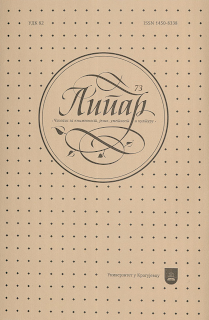ПРАВОПИСНЕ ГРЕШКЕ У МЕЂУЈЕЗИКУ СРБОФОНИХ СТУДЕНАТА КОЈИ УЧЕ ТИПОЛОШКИ СРОДНЕ ЈЕЗИКЕ (ИТАЛИЈАНСКИ КАО L2 И ШПАНСКИ КАО L3)
ORTHOGRAPHIC ERRORS IN THE INTERLANGUAGE OF SERBOPHONE STUDENTS LEARNING TYPOLOGICALLY CLOSELY RELATED LANGUAGES (ITALIAN AS L2 AND SPANISH AS L3)
Author(s): Marija N. VujovićSubject(s): Language studies, Language and Literature Studies, Foreign languages learning, Applied Linguistics, Sociolinguistics, Descriptive linguistics, South Slavic Languages, Philology, Translation Studies
Published by: Универзитет у Крагујевцу
Keywords: orthographic errors;interlanguage;transfer;language distance;L2;L3;Spanish;Italian;Serbian
Summary/Abstract: The studies that analyze the interlanguage of plurilingual speakers have been the focus of linguists’ interest for the past three decades, since empirical researches have proved that both students’ mother tongue and non-mother tongue can be a resource for transfer when learning a new language. The paper analyzes orthographic errors made by Serbophone students of philology who study two typo- logically similar languages - Italian and Spanish, which arose as a result of a negative transfer from one language to another. The presented errors prove that the negative transfer is stronger in typologically closely related languages than in those that are not, regardless of the order of acquisition (De Bot, 1992; Williams & Hammarberg, 1998; Jarvis, 2000; De Angelis & Selinker, 2001; Cenoz, 2001; Ecke, 2001; Hammarberg, 2001; Ringbom, 2001). Due to the factors of language distance and psychotypology that influenced the appearance of transfers, it has been proved that interlinguistic similarities are the ones that caused the largest number of errors (Swan, 1997) and the appearance of negative lateral transfer, i.e. negative transfer from the second to the third language. The errors did not occur exclusively due to ignorance of the rules of the Spanish language, but they were caused by the influence that the knowledge of the previously acquired Italian had on learning Spanish. Thus, most of the errors were interlingual. Many errors identified in the corpus would not have been made by students who had previously learned another foreign language typologically distant from Spanish. As the largest number of orthographic errors was identified in words that are the same or similar in Italian and Spanish, the claim of many linguists (Wil- liams & Hammarberg, 1998; Cenoz, 2001; De Angelis & Selinker, 2001; Ecke, 2001; Hammarberg, 2001; Ringbom, 2001) that the typological similarity between L2 and L3 facilitates language transfer has been proved. Thus, when studying transfer, one should pay attention not only to the influence of the mother tongue on the target language, but also to the influence of L2 on the target language, especially in the case when L2 is typologically closest to the L3.
Journal: Липар - часопис за књижевност, језик, уметност и културу
- Issue Year: XXI/2020
- Issue No: 73
- Page Range: 217-231
- Page Count: 15
- Language: Serbian

